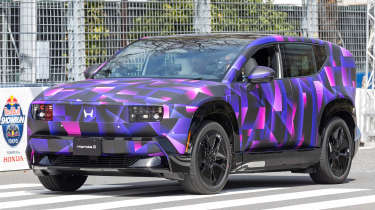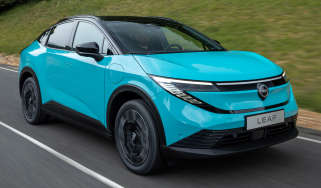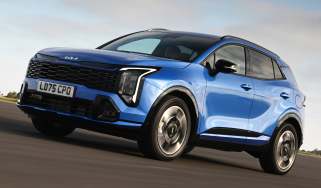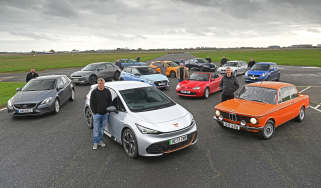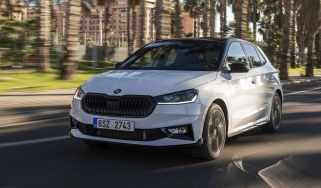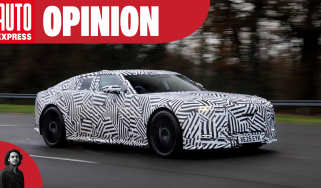New 2026 Honda 0 SUV: Japanese brand to finally have an EV to rival Tesla and BYD
Honda EV plans are gathering momentum, and they’ll be realised in the groundbreaking 0 SUV next year
Honda is on the cusp of launching its most ambitious new vehicle in a generation – and incredibly it’s been sitting right under our noses for the best part of six months.
That’s because the Honda 0 Series SUV Concept that was revealed at CES in Las Vegas this year has lost its ‘concept’ tag, and now carries a ‘prototype’ label, alongside confirmation that it’s pretty much the car that we’ll see on the road in 2026.
There’s been a lot of discussion of late about how relatively new manufacturers such as Tesla and BYD seem to have seized the initiative from legacy brands in Europe and Japan, but just as Volkswagen and Stellantis are proving for the Europeans, Honda is about to prove that the Japanese haven’t been caught napping either.
The company has been methodically working away in the background on tech that should bring it right back to the fore, starting with this SUV, which will target the C and D segments.
High-sellers the 0 SUV is sure to have its sights set on include the Tesla Model Y, Hyundai Ioniq 5 and Skoda Enyaq, thanks to a groundbreaking blend of technology, packaging and design.
And the 0 SUV is just the start, with the even more ambitious 0 Saloon destined to follow only a few months after SUV production kicks off in late 2026.
We were recently granted some time with the 0 SUV prototype, and while there are certainly a few concept car flourishes still in place, we were left with a hugely positive impression of a car that’s realistically still two years away from being available here in the UK. Here’s why we think the Honda 0 SUV might just be one of the most effective models yet to deliver Japan’s traditional mastery of consumer electronics in an effective package for the road.
Chassis and packaging
At the heart of Honda’s new-generation EVs is a brand new, bespoke architecture that’s been designed from the ground up on a core set of principles: “light, thin and wise”. While this might sound like the sort of marketing guff so beloved of car makers, the proof is in how the 0 SUV and Saloon look, as these principles determine both cars’ fundamental packaging.
The key difference here, is that just as Tesla does now – and how VW, Mercedes and BMW will all soon do with their future-generation EVs – Honda has developed a new way of integrating the batteries directly into the base of the chassis floor, reducing the cabin height and therefore unlocking more space inside.
When applied to an SUV like the 0, this means that the cabin can feel considerably more spacious without the need to go too high with the roofline. This helps improve aero efficiency and reduces the need to counteract the ‘pendulum’ feeling that can afflict some all-electric SUVs with high driving positions.
The new 0 SUV will have a markedly different type of body structure to all former Hondas, too, with a huge pulled-back windscreen, a glass roof and thin pillars to let in as much light as possible. The rear end’s controversial van-like design is there for a reason, too – opening the boot will free up a huge, variable space inside that doesn’t just prioritise the area under a traditional parcel shelf, but everything up to the roof.
Honda has also mounted a couple of small cubbies with drop-down doors that act as shelves. We’ve been told this will all make production.
In the case of the 0 Saloon, the architecture totally changes the game by allowing Honda to drop the seating position to an exceptionally low position and therefore bring the roofline down with it. Other elements, such as a glass roof and thinner seat bases, also help in this respect, diluting the chunkiness we currently see on many modern EVs.

Getting the structure right
But there’s more happening elsewhere, with Honda investing in the latest, Tesla-style aluminium castings for large parts of the chassis. This doesn’t just reduce complexity in manufacturing, but also creates a stiffer base to mount the suspension to, in turn improving refinement and structural rigidity.
Honda has employed the same trick with its battery casing, reducing the part count from 60 to just five. All in, the company says this new manufacturing method reduces weight to the tune of around 100kg in the upcoming 0 SUV, compared to traditional pressed and welded parts.
This will all work with Honda’s latest generation e-motors, which are smaller and more power dense than before, with weight cuts to the tune of 40 per cent in the electronics and inverter also helping things along.
Honda hasn’t confirmed specific battery chemistry or sizes yet, but does say that the packs will be class competitive, even against rivals we’re expecting to launch in the next two years. Both saloon and SUV models will feature either a single, rear-mounted motor or an optional dual-motor set-up with between 241bhp and 480bhp.
The move to a software-defined vehicle
To best coordinate all the electronic systems, it’s now widely recognised that a central digital brain is the way to go. This is a route that many new breakthrough EV makers have gone down, and the legacy brands are set to follow in the next few years. Commonly referred to as a ‘software-defined vehicle’, it will be introduced by Honda on the 0 SUV.
What are the immediate benefits? To begin with, Honda will be able to dramatically speed up the development process by having a far more substantial digital starting point to work from. Different electronic modules, features or hardware will no longer need to be engineered to speak to all the car’s individual systems; rather they’ll only have to communicate with one, at the centre of everything.
It also allows for more customer-oriented benefits, too. These include the ability to adopt expanded over-the-air updates; quicker and more reliable charging with a better ability to ‘speak’ to public charging stations; and a faster-reacting connection between dynamic chassis elements such as adaptive dampers, electric power steering and the e-motors.
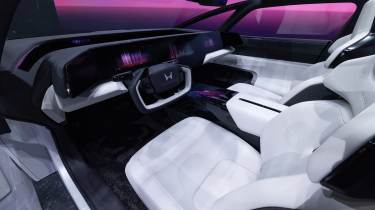
Interior and infotainment system
Honda is promising a major step forward with the interior experience, as it seems the company has finally realised the importance of an integrated infotainment system that feels at one with the whole driving experience, rather than a set-up that seems an afterthought.
This will take the form of Asimo OS, Honda’s new user interface system named after the company’s iconic robot of around 20 years ago. The Asimo interface will be all-new, and focused around the user first and foremost. The concept has no physical buttons inside, and nor will the production car; instead the large central screen will be committed to most of the car’s functions. We’ll see if Honda has been able to succeed here, where others, including VW, have failed.
The 0 SUV also has a controversial yoke-style steering wheel, and Honda is working on a steer-by-wire system to go along with it. This removes the physical connection between the steering wheel and the front wheels, with the ability for software to vary the steering ratio depending on the specific driving scenario. This is technology we’ve already seen on vehicles such as the Lexus RZ and Tesla Cybertruck.
Space inside is decent, and while there is still plenty of headroom, the new battery layout has left a good amount of space under the front seats for rear passenger foot room. The 0 SUV is wide, but also lower and shorter than the existing SUVs it plans to rival, and feels generous enough considering its external dimensions.
Honda says this is another key part of its new generation of models, and points to its innovative models such as the Jazz and original CR-V as a reference for the space efficiency it’ll employ in the 0 SUV and other cars.
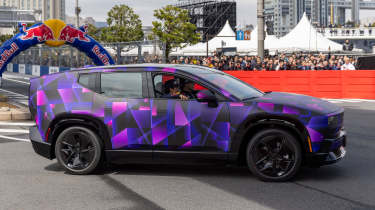
Max Verstappen has already had a drive…
Honda’s desire to bring the 0 SUV to market unchanged from the original concept was confirmed recently when a road-going prototype was put on show with Formula One champion Max Verstappen at the wheel.
As the images show, there’s almost nothing that’s been changed between the concept and the prototype road car, giving us confidence that the vehicle we’ve now seen and experienced will be pretty close to the 0 SUV you’ll be able to go out and buy.
Production of the Honda 0 SUV will begin next year, first going on sale in North America. It will then make its way into global markets, including Europe and Japan, with the UK likely to be an early recipient in 2027.
Did you know you can sell your car with Auto Express? Get the highest bid from our network of over 5,500 dealers and we'll do the rest. Click here to try Auto Express Sell My Car now...
Find a car with the experts


